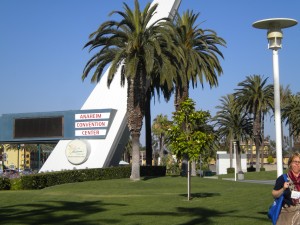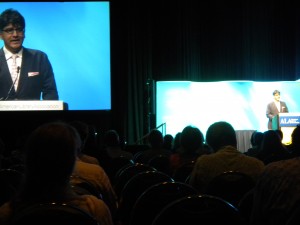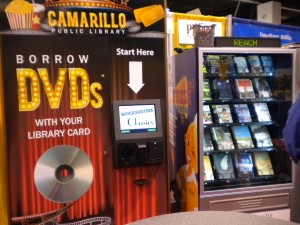This year, I had the immense good fortune to represent UBC in the Student-to-Staff program at the American Library Association (ALA) conference. The following blog post outlines my experiences and the sessions that I attended. I tried not to make it excessively long, but I also wanted to impart the knowledge that I received to my fellow SLAISers.
ALA Conference 2012

There are few things more gratifying than meeting new people with whom you share a common interest. Imagine being surrounding by thousands and thousands of them! This was exactly the case at the ALA Conference, held in Anaheim, California from June 21st through June 26th. I was quite unprepared for the scale of it; there were over 14,746 librarians and 5,388 exhibitors. Upon checking in at the Anaheim Convention Center, I was given a 319 page program guide large enough to be a phone book for a decent sized city. There were so many interesting programs running simultaneously that it would have been extremely difficult to attempt to choose between them. Luckily, as part of the Student-to-Staff program, I was assigned to volunteer with the Public Libraries Association (PLA), monitoring some of their sessions, and most of those that I attended were chosen for me.
My volunteer assignment was to monitor specific PLA sessions, make sure that ordered equipment was present, and to write up a report about each session to hand in to my supervisor at the end of the conference. Although I was assigned to a unit specializing in public libraries, many of the sessions that I was assigned to attend were broad enough to be applicable to many different library fields.
The first session that I monitored for PLA was directed more at aspiring authors than librarians. Gene Del Vecchio spoke about his new book Creating Blockbusters. In it, Del Vecchio utilizes his expertise of the entertainment industry and recent research he had completed to illuminate the elements of novels, films and television series that make them hugely successful. He highlighted eleven principles that contribute to a work’s success; the more principles that apply, the more successful it is likely to be. I don’t want to spoil the book by giving away too much information, but if you have an interest in writing, I would recommend checking it out. This session was very engaging, and actually ended up being one of my favorites. Unfortunately, because John Irving was speaking next door at this exact time, it was poorly attended.
The second session that I monitored, Guts and Glory: What it Takes to Lead, was an inspirational presentation about how librarians are now in a position where they must lead the profession in a direction that will enable them to remain relevant amid a changing technological and economic landscape. The speakers emphasized that libraries must become the hubs of their communities. Librarians must go beyond old ways of thinking about the profession and have the “guts” to evolve their job roles in order to provide the services most needed by patrons in today’s world.
One of the speakers, Sari Feldman of the Cuyahoga County Library, outlined six priorities she believes to be essential for libraries of today:
- Advocate for your library: Create an understanding of the library’s value
- Reconnect; Libraries need the larger system more than it needs us
- Alliance building (Such as actively sitting on boards)
- Be inspired, inspire others
- Take risks, be open to new experiences; Everybody leads
- Maximize customer input
Another presenter, Cynthia Kurtz, argued that libraries need to self-assess the relevancy of their services. She spoke about the growing gap in work related skills, and suggested that the library should offer services that support continuing education programs, and job training. She stated that libraries need to become a part of economic drivers. The library can keep relevant by evolving into more of a place that people can utilize in preparation for a return or entrance to the work force. Kurtz asserted that our generation of librarians is going to be the one that bears the responsibility for changing their roles and saving the library.
Next, I attended Best Practices in Collection Management. This session went over a LOT of material, and much of it you will learn if you take the SLAIS Collection Management course, so I will just go over their discussion of floating collections, which I found very interesting.
Floating Collections have been a part of library systems for over ten years now. All the speakers in this session reported that at least some of their collections float from branch to branch. There are many reasons to have floating collections, including:
1) More and faster access to materials (Patrons not waiting for in-transit items)
2) Decreased staff handling of materials = more time can be spent on other activities
3) Decreased delivery cost
4) More items available
5) Stretches the material budget
6) Collections are revitalized (Patrons see different items each time they visit the library)
Potential challenges with this model occur when branches become cramped with materials while others may begin to temporarily have diminished collections. Additionally, weeding may be a challenge because these materials have ceased to belong to one branch.
The Great Non-Fiction Read-alike: If You Like This, You’ll LOVE That was just as good as any candy being handed in the conference exhibition hall. Not only was this a fun session, but it also came at a perfect time- just when I finished a book and was looking for some new recommendations! Luckily, this one was made available online.
The primary message conveyed at the conference session, Dangerous Ideas: What if We Took Volunteers Seriously was that public libraries need to take measures to give back to their volunteers. Public library volunteers are 80% comprised of young adults. Dr. Anthony Berner stressed that the best thing that the library can do for its young volunteers is to prepare them for the labor market by training them to have essential job skills and to provide for them an experience that they can reflect on their college or future job applications.

Sherman Alexie’s speech at the PLA Awards Ceremony was one of my favorites of the conference. The gist of his message was that while information is plentiful and easily forgotten, the role of librarians as keepers of the knowledge in the collective consciousness is among the most important in society. To illuminate his point, Alexie called attention to the story of Mike-the-Headless Chicken (and had many librarians discretely Googling the name to verify the validity of the tale). Mike-the-Headless chicken continued to run around, pecking for food, despite his recently severed head. Alexie pointed to this largely unheard of story in order to playfully convey the value of a librarians’ job to hold onto stories so they are not forgotten.
The final session that I attended was Digital Inclusion: Libraries Transform Communities. Librarians from the Colorado State Library and the Free Library of Philadelphia shared their experiences with implementing technology labs that aimed to increase patron digital literacy. Through tracking these programs, it was discovered that many patrons did not understand the value of acquiring internet skills. These centers have been utilized largely by job seekers, new Americans and students. One massive issue with creating library technology labs is that there are currently no sustainable grants.

Camarillo Public Library DVD vending machine
All in all, this conference got me very excited to start bringing my own ideas to the table. If ever there was a doubt in my mind that I was going into the wrong profession, being in the midst of the buzz of ideas from so many passionate, intelligent and caring librarians washed it away.
Here’s my final thoughts and advice for those considering attending the next ALA conference
1) Go!! The ALA Midwinter Conference just happens to be in Seattle this year- very convenient for SLAIS students! I highly recommend that you take advantage of it. Not only do conferences such as ALA offer great professional development and networking opportunities, but they are also a great way to re-energize you from a potentially exhausting school year.
2) Dress warm! If other convention centers are anything like the Anaheim Convention Center, it’s something like stepping into the depths of winter. Wear a sweater!
3) Be sure to read the conference program schedule carefully. I know it’s long, but there are some really great/fun events that take place that can become buried by the sheer mass of content. One of the coolest things I was able to do at the conference was to watch a special pre-screen showing of The Perks of Being a Wallflower, which included a free book and signing by the author, Stephen Chbosky. Had I not learned of this opportunity at the last minute through a passing remark, I would have really missed out on something awesome!
4) Be brave- talk to people. Initiating conversations with new people (particularly people with jobs) may be intimidating, but you never know what new collaborations, jobs or friends may come of it.
Thanks for reading! Hopefully I will see some of you at mid-winter!



